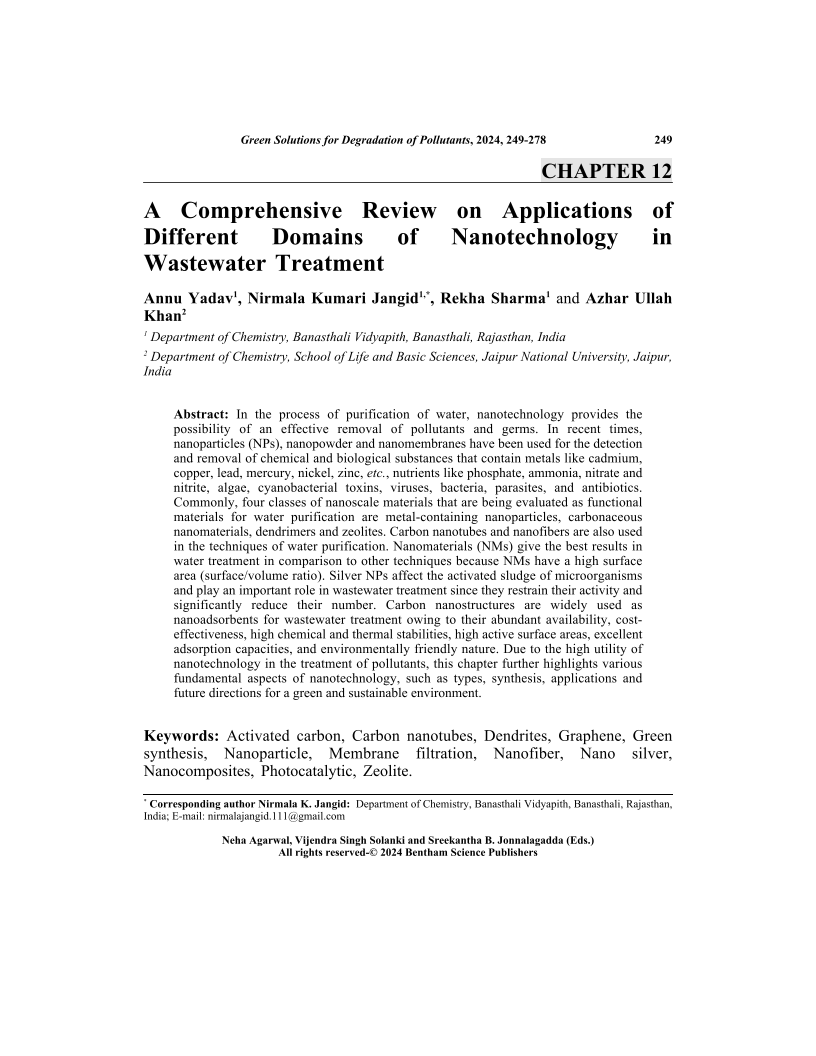A Comprehensive Review on Applications of Different Domains of Nanotechnology in Wastewater Treatment

- Authors: Annu Yadav1, Nirmala Kumari Jangid2, Rekha Sharma3, Azhar Ullah Khan4
-
View Affiliations Hide AffiliationsAffiliations: 1 Department of Chemistry, Banasthali Vidyapith, Banasthali, Rajasthan, India 2 Department of Chemistry, Banasthali Vidyapith, Banasthali, Rajasthan, India 3 Department of Chemistry, Banasthali Vidyapith, Banasthali, Rajasthan, India 4 Department of Chemistry, School of Life and Basic Sciences, Jaipur National University, Jaipur, India
- Source: Green Solutions for Degradation of Pollutants , pp 249-278
- Publication Date: August 2024
- Language: English
A Comprehensive Review on Applications of Different Domains of Nanotechnology in Wastewater Treatment, Page 1 of 1
< Previous page | Next page > /docserver/preview/fulltext/9789815238969/chapter-12-1.gif
In the process of purification of water, nanotechnology provides the possibility of an effective removal of pollutants and germs. In recent times, nanoparticles (NPs), nanopowder and nanomembranes have been used for the detection and removal of chemical and biological substances that contain metals like cadmium, copper, lead, mercury, nickel, zinc, etc., nutrients like phosphate, ammonia, nitrate and nitrite, algae, cyanobacterial toxins, viruses, bacteria, parasites, and antibiotics. Commonly, four classes of nanoscale materials that are being evaluated as functional materials for water purification are metal-containing nanoparticles, carbonaceous nanomaterials, dendrimers and zeolites. Carbon nanotubes and nanofibers are also used in the techniques of water purification. Nanomaterials (NMs) give the best results in water treatment in comparison to other techniques because NMs have a high surface area (surface/volume ratio). Silver NPs affect the activated sludge of microorganisms and play an important role in wastewater treatment since they restrain their activity and significantly reduce their number. Carbon nanostructures are widely used as nanoadsorbents for wastewater treatment owing to their abundant availability, costeffectiveness, high chemical and thermal stabilities, high active surface areas, excellent adsorption capacities, and environmentally friendly nature. Due to the high utility of nanotechnology in the treatment of pollutants, this chapter further highlights various fundamental aspects of nanotechnology, such as types, synthesis, applications and future directions for a green and sustainable environment.
-
From This Site
/content/books/9789815238969.chapter-12dcterms_subject,pub_keyword-contentType:Journal105

